A few years ago when it was clear that Virtual Reality headsets were going to be a reality, I sensed that this would be the biggest (and maybe the last) opportunity for exergaming to make a “comeback” after it so dramatically burst on the scene and then disappeared back in the mid-2000s. As those of you who’ve followed this blog in any of its previous incarnations (Nutwiisystem.com, PS3Fitness.com, 3dPlaystation.net) know, the “holy grail” I’d been seeking for so many years was a active gaming experience on a console so immersive and compelling that “you got a workout without even realizing you were exercising”. We’ve come close over the years, with popular games like Just Dance for the Wii, Kung Fu for Kinect for the Xbox One, and Move Fitness for the PS3. But as fun as those games were and as captivating as the experiences became, you never quite forgot that you were in front of a TV as you tried to stay within the game console sensors.
So I’ve decided to be an early adopter to virtual reality technology. But that begged the question, do I choose an HTC Vive, an Oculus Rift, or a Playstation VR? In my last post on the subject I went through the rationale of why I was choosing the PSVR and the Playstation 4. The main reason came down to cost: it’d cost close to $2000 for me to buy a new high-end PC and an Oculus or Vive, when it’d be closer to $800 for me to get both a new PS4 and a PSVR.
But User-friendliness was another reason. I tried out the Vive at my brother-in-law’s place recently and I was impressed by the technology, but as with a lot of things in the PC gaming world, setting it up and using it just felt more involved and “technical” than I would have liked. While I’m a pretty technical person in my work life, in my leisure time, I really just prefer not to think too much to set up hardware and software. I just want to start using it. So that reinforced my decision to go with the PS4, as Sony has a lot more experience with “plug and play” than Oculus/Facebook or HTC.
Honestly, I hadn’t really been planning on getting a Playstation 4. There just aren’t enough hours in a day for me to play console games anymore. But with the potential of virtual reality for fitness, suddenly that equation changed. From a perspective of time, I wouldn’t be wasting time playing video games if that playing resulted in me working out and improving my health. And from a cost perspective, the cost would be comparable to buying an expensive piece of home exercise equipment or a gym membership–with the difference being that I’d actually use it.
So throwing caution to the wind, I bought a Playstation 4 Pro and a PSVR, knowing full well that there weren’t likely to be any mainstream game developers developing “active games” for them today. This is thanks largely to Microsoft. Remember when they tried to “force” all their users to the Kinect? There was a huge backlash from the gaming community, and most industry experts point to that as the moment that the Xbox One was forever doomed to lag behind the PS4–and that motion controls in gaming officially died. Not soon after that, Microsoft, Sony, and even Nintendo abandoned active games and motion controls.
While executives at Microsoft are probably still scratching their heads at why the Kinect failed, to me the answer has always been obvious. With the exception of Nintendo and maybe one or two independent developers out there like Virtual Air Guitar, most developers just didn’t “get it” when it came to motion controls. They lazily tried to develop video games the way they always did and slap the Kinect interface over them, essentially making motion controls just a proxy for button mashing on a controller. The result was awkward experience after awkward experience.
In a signal that they didn’t “get this” either, a few months ago Sony put out a statement stressing that all PSVR games WOULD require Dualshock Controllers. Luckily there was a backlash the other way and they quickly backtracked and said that some PSVR games MAY NOT require Dualshock Controllers.
To Sony’s credit, something else they did was rather than tossing the Playstation Move (which had always been pretty good technology), they’ve decided made it part of the PSVR experience, to the point of including it in the launch bundle. I think this was prescient of them. While the marketing folks at Sony are clearly skittish, my prediction is that once people try out a few VR games, they will DEMAND motion controls. In other words, players of virtual reality games want to replicate “real” reality–and the reality is that most of us “move” when interacting with our world.
But we will probably have to wait a bit. Looking over the launch titles it looks like most games still depend heavily on the DualShock and/or your head movement to control things. And even games that do use the Move controllers seem to do so fairly passively–you use the Move controllers to pick up and examine objects, shoot a gun, and so on. So as far as the launch titles go, there doesn’t seem to be much as far as “PS4 fitness games” go as far as creating games that will get you sweating and your heart rate up.
But hopefully once enough people adopt the technology some independent developers will start to “get it” and develop native VR games that toss away old paradigms. Here’s hoping that someone, somewhere is working on games that’ll let you go boxing, hit a baseball, swing a tennis racket, and so on.
That said, I’m always scouring the Playstation Store online to see if there are any games that might fall into the category of an active game that’s good for a workout. If you hear of any PSVR games that sound like they might be good for exercise and workout (or if you’re a developer working on such a game), definitely let me know in the comments and I’ll be happy to showcase it here.
Having said that, here are some of my first observations about the VR technology itself.
Playstation VR
To be honest, my first impressions of my new PS4 really weren’t much different than my old PS3. Granted, it has better better graphics (and still no 4K Blu-Ray…why, Sony, why?). But outwardly, it doesn’t seem too much different than the big black box that was the PS2 and the big black box that was the PS3.
On the other hand, the PSVR unit impressed me as soon as I unboxed it. I decided to go for the launch bundle.
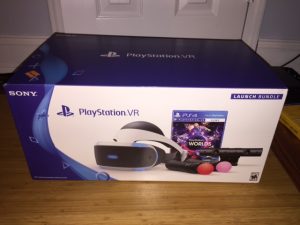
Opening the box there were two other boxes, one holding the Playstation Worlds CD, the Move controllers, and the Playstation 4 Camera, and the other with the PSVR unit.
They clearly engineered the PSVR box not just to be utilitarian but also to be impressively designed a la Apple. The box is made of thick glossy cardboard, the top cover dramatically opens to reveal the contents (and stays propped open with a built-in strap), and inside you’ll find all the parts neatly organized in other boxes, underneath which is the VR headset itself. It was clearly designed to reflect a premium product.

It could have been an involved process getting it set up, but they made it easy by including a giant instruction manual with big, clear pictures for each step–literally devoting a page for each time you have to unplug or plug a cable.

Every included cable is even tagged with a large number tag, which is repeated on the outer box and in the manual. Clearly unlike HTC and Facebook, they intend to sell this to the masses and not just to techies. It’s really hard to mess this up.
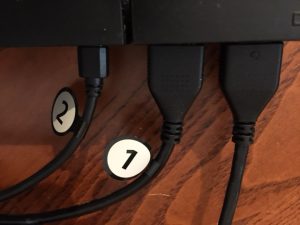
The parts consist of the VR headset, a processor unit (controller box), an HDMI cable, a USB cable, an AC adaptor and power cord, a connection cable for the VR headset with two plugs on one end and two jacks on the other, and stereo headphones. If you bought the launch bundle you also got a Playstation 4 camera (required) and Move controllers (required for certain games).
They made installation pretty simple. All wires go into what they call the Processor Unit, which is the “brains” of the PSVR.

It has ports for a power, a micro USB connection to the PS4, an HDMI connection to the PS4, an HDMI connection to your TV, and two jacks for you to plug in the cable to the PSVR headset.
To start, you basically need to unplug your HDMI cable from your PS4 and plug it into the VR box. You’ll plug a new HDMI cable from the box to your PS4. This allows video signals to be sent to the VR headset’s OLED display.
You also will need to plug your Playstation Camera into your PS4, if you haven’t already. This is not the same Playstation Camera for the PS3. It’s a unit with two lenses about the size of a large roll of Menthos that you put in front of your TV screen. You should also install your PS Move controllers if you haven’t already (these are the same that they sold for the PS3).
Finally, you plug the VR processor box’s power adapter into an AC outlet, and plug the VR headset to the VR processor box using a long cable they included.
The cable was the one thing I wasn’t crazy about with the PSVR–I like the fact that they made it long so you can sit plenty far from your TV, but the way the cable goes into the headset it always seems to get in your way when you try to put the headset on and off.
The headset consists of a bulky white headband holding bulky lenses that look like a cross between ski goggles and a Star Wars stormtrooper mask.

It took some getting used to getting it to fit properly on my head, but it’s pretty well engineered to accommodate just about any head size and shape.
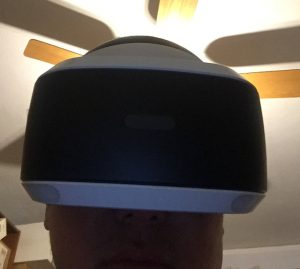
You can expand the circumference of the headband to accommodate individuals of any head size by pressing a white button on the back and stretching it, or you can tighten it by rotating a round gear.

Similarly, by pressing a black button on the bottom, you can move the goggles closer to or away from your face to ensure a snug fit against your face.

Between the cables, adjusting the top band for your head, and adjusting the snugness of the goggles to your eyes it takes a bit of effort to get your headset on. But after about 10 tries I finally was able to get it on and off pretty quickly. I wear glasses, but the goggles fit perfectly on top of them.
You then power on the PSVR unit by pressing the power button that’s on a small control unit on the long cable (which also includes volume control, a headphone jack, and a mute button). They wisely didn’t make all the buttons the same feel–the volume buttons stick out, while the power button is flush with the unit, so you don’t have to guess when you’ve got the glasses on and are pressing it.
When you look through the goggles, you’ll see the familiar Playstation 4 menu interface, clear as a bell (if it’s not clear, just shift the headset around a little until it fits snugly, you see a clear picture, and the black silicone flaps to your left and right are comfortable and properly blocking the outside light). From there, you’re no longer interacting in the real world but the virtual world.
One thing that disappointed me was that unlike the HTC Vive, which lets you press certain buttons to let you “scan” your real world surroundings while you’re wearing the VR goggles, with the PSVR you’re completely blind to the outside world. So before you put the glasses on, just make sure you’re far away from people, animals, and furniture.
You can navigate the menu by using the Dualshock controller. One thing I tried right away was opening Netflix. That was my first mind-blowing experience. Instead of watching a movie on a TV, you’re watching in on what feels like a big screen in a theater. Granted, the resolution of the glasses is not as fine as its competitors (the Vive and Oculus both have two 1200 x 1800 pixel OLED displays for a total of 2160 x 1200 pixels vs the PSVR which displays 960 x 1080 per eye using one 1920 x 1800 OLED display), but it makes up for it with a higher refresh rate (120Hz on the PSVR vs 90Hz on the Vive and Oculus). For a first generation product, I was impressed by the picture quality.
Playroom VR
When you purchase the PSVR, the only “free” game you get straight away is one you can download from the Playstation Store called Playroom VR. It offers five mini-games. None of them are really “active games”, but all of them do a fantastic job of showcasing the basics of virtual reality, as well as showcasing how VR doesn’t have to be a lonely one-person affair. Most of the games are party games where the developers incorporated multiplayer action into games, where one player is wearing the headset and using a Dualshock controller and up to four friends are interacting with the TV screen using additional Dualshock controllers.
Robots Rescue (1-4 players) – This is by far the best game of the lot, and the first one that elicited a real “whoa” reaction from me. 20 of your robot friends are being chased by evil “blocks” and are hiding throughout a virtual world. Your job is to seek them out.
What I love about the 3D effects are that they’re subtle and not in-your-face “look how cool VR is”. When you start the game, you look down at your hands and your Dualshock controller is transformed into a brand new robot-catching controller. When you find a robot, your robot “boots” it and it goes flying right into your controller and waves happily back at you. As you walk along a cliff, you can peer over the edge and see way down over the edge (if you experience vertigo or acrophobia the effect may be a little too real for you). And of course, you can explore your world left, right, up, down, backwards, and forward. This is the one game of the lot that can be played solo (although if you want to catch all 20 robots you will need help from a player on the TV).
Cat and Mouse (2-4 players) – The main player using the headset is a “cat” hiding behind a curtain, while the other players watching the TV are mice trying to collect cheese without the cat seeing them whenever the curtain opens.
Monster Escape (2-4 players) – The main player is a “sea monster” that uses his head to destroy buildings, knock down helicopters, and attempt to hit the TV players running away. The TV players run away and pick up debris to throw at the monster a la dodgeball.
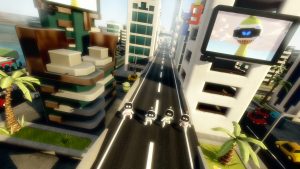

Wanted (2-∞ players) – The VR player is a sheriff in a Wild West setting attempting to shoot bandits, but with no idea who the bandit is. The players watching the TV see the bandit and have to describe different features so the VR player can identify him.


Ghost House (1+ players) – There was a rather ingenious game for the Wii called Wii Play Motion that used sounds and vibrations on the Wii controller to let players “hunt” for ghosts around the real room. This game brings that idea to fruition by letting the VR player literally look around the room to follow the ghost around.
Playstation Worlds
If you bought the launch bundle of the PSVR, you also got a game called Playstation Worlds. This game can also be purchased separately for a retail price of $59.99, but honestly, they should have included it free in every PSVR, because like Playroom VR, it’s really not much more than a set of relatively short technical demos.
I wish Sony would have learned the lesson from Nintendo and Wii Sports that in the long run they’ll make more money with new technology if they can convince users to adopt it first–and that sometimes means “giving away” enough to ensure that their first experiences with the technology will be amazing. But some number-cruncher at Sony obviously felt that they could make money off this by selling it separately.
As a standalone game, Playstation Worlds feels like it’s missing depth. But as a tech demo, it does a fabulous job of showcasing the potential of virtual reality beyond what Playroom VR could. Again, it consists of five standalone (and relatively short) experiences, all for single players wearing the VR headset.
The London Heist – Here, you find yourself locked in a dingy room with a big mean-looking British guy with muscles and tattoos hovering over you, apparently holding you hostage. It’s not a pleasant feeling, but that’s by design. There are a few gimmicky moments (such as when the guy points a gun at you, which is about as unsettling as it would be in real life), but for me, the “whoa” moment was when he puts some things on a table for you to interact with–a lighter, a cigar, and other mundane objects which you’ll gasp at how realistic they look. You can pick them up and examine them as if they were real objects, holding them close to your face and rotating them to view them in 360 degrees. The effect was stunningly realistic (and all the more realistic when you use the Move controllers).
From there, you embark on a few short adventures where you get into a shootout, a car chase, and other typical experiences. Perhaps because they knew that no one under 12 would be using the PSVR, they decided to make this game “M for mature”, which means real blood and gore and lots and lots of uses of the “F” word. Honestly, I found the game itself to be pretty gratuitous and contrived and the “storyline” weak, but of course the main purpose of it was to show off 3D, which it does stunningly well.
Ocean Descent – This is a passive experience where you’re in a cage underwater and the cage dives down into the deep sea. Not much to do here but watch and enjoy the scenery, which is pretty well done and I’m guessing pretty accurate as you dive into deep sea. I enjoyed not just viewing the sights outside, but also just the process of looking around and examining the detail of the cage I was in.
Scavengers Odyssey – Here, you fly a spaceship around shooting things, and then land on a planet, shooting things. Again, the thing I was most impressed with at first as just looking down at my chest and my lap and hands and seeing someone else’s body. But flying through the stars is also an exhilarating experience.
VR Luge – Remember a Playstation Move game called “Kung Fu Rider” where you glide down the road in an office chair? For the VR they went the slightly less silly route and have you glide down roads lying on your back on a skateboard. You steer by moving your head left and right and let “gravity” do the rest. This is by far the fastest action of all the games, and is served well by the PSVR’s quick refresh rate.
Danger Ball – This is essentially Pong in 3D. It plays a lot like racketball in that you’re in a square court and hitting a ball to try to get it past your competitor. You control the action by moving your head up, down, left, and right. This is one where the Move controllers probably would have made more sense, but using your head works too.
Like I said, you won’t get much of a workout playing any of these games. Your heart rate might elevate a little at moments like when the British dude is pointing a gun at your head, and you may have a sore neck after playing too much Danger Ball, but that’s not going to help you lose weight.
That said, despite Playstation Worlds being sold as a standalone game, I’d consider both Playroom VR and Playstation Worlds as very polished tech demos that do a great job of showcasing the potential of VR.
But again, as far as exercise and working out, of course neither of these games do that. But I’ll be following up this post with exciting news on what I consider the killer app for virtual reality and fitness. Stay tuned.

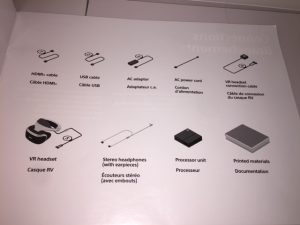


4 Comments
Alternatives to Netflix
Feb 13, 2017 7:41 pmVideo game + fitness nice idea
Will
Mar 22, 2017 10:51 amWhat’s the follow up to this please?
Temain
Apr 21, 2017 9:02 amSteve, I liked this article, but it is another reminder I am going to lag another technology decade based on cost, happily sweating in front of PS3 instead. Referring to your article http://gaming.fit/review-of-adidas-micoach-for-playstation-move-micoach-ps3.html ,
I wonder if you have archived any specific user experience & analyses on this game. Adidas has abandoned that game ~1 year ago, the original support / developer groups are all hiding under the table, the old user group seems unreachable (claimed too small to support by Adidas), not much is documented online in public domain. My question: what do you know about the Game Engine’s ‘Fit Level’ assignments, what is the maximum LEVEL, how does a particular LEVEL stack up to biometric values (e.g. does a Level 7 strength workout belong to poor/mediocre/average/fit/athletic/champion types, or is it just a dumb and linear awarding system that increases workout intensity without end; is the behaviour of that LEVEL system DIFFERENT if you’d use an ANT+ pulse monitor with a USB receiver plugged into the PS3?
PSVR Guy
Sep 03, 2017 1:07 amTime for you to try out Sparc……..talk about a workout!